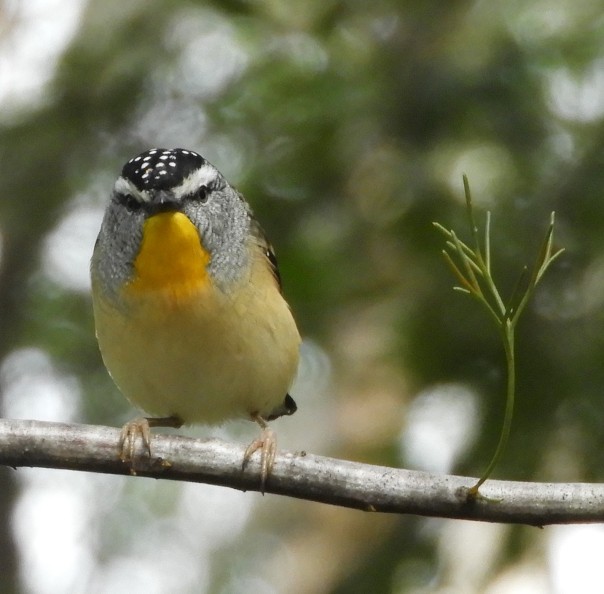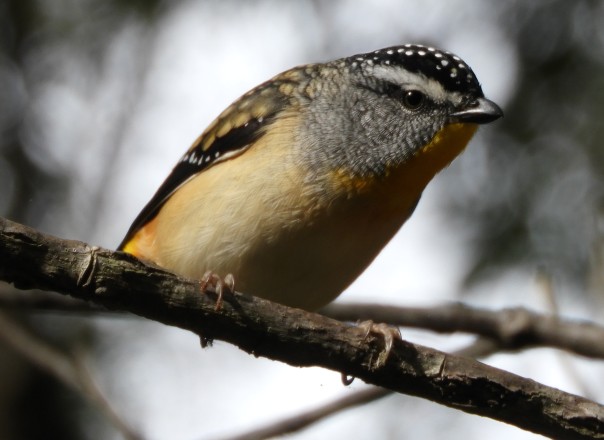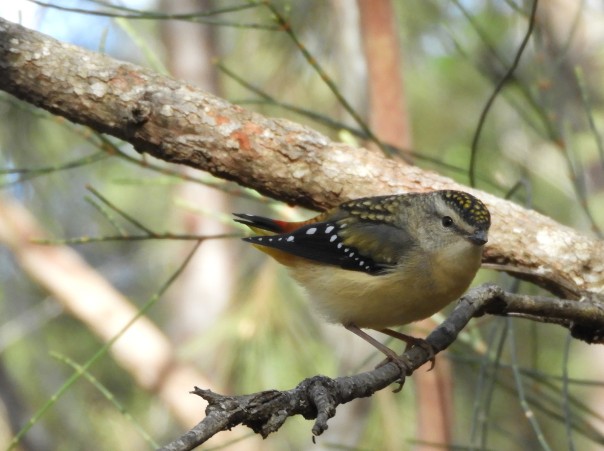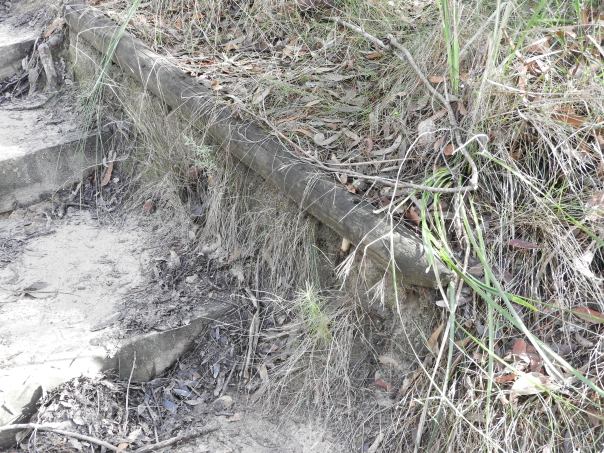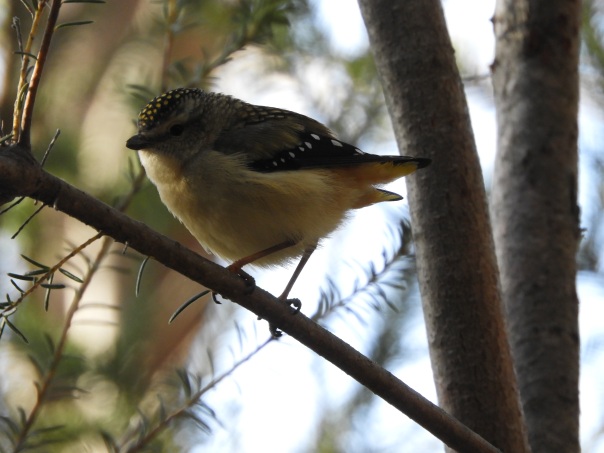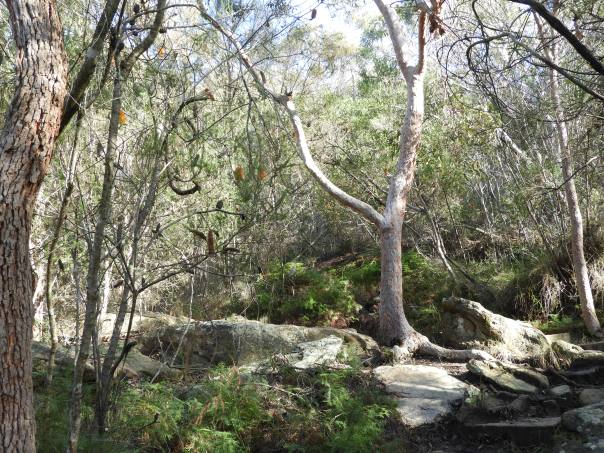Category Archives: Pardalote
Neat Spotted Pardalote
Spotted Pardalotes are tiny little birds with neat patterns and colours on their heads and bodies. They flit around high in the trees or deep in the undergrowth, so it’s a treat when one stays still long enough to get a good look at you.
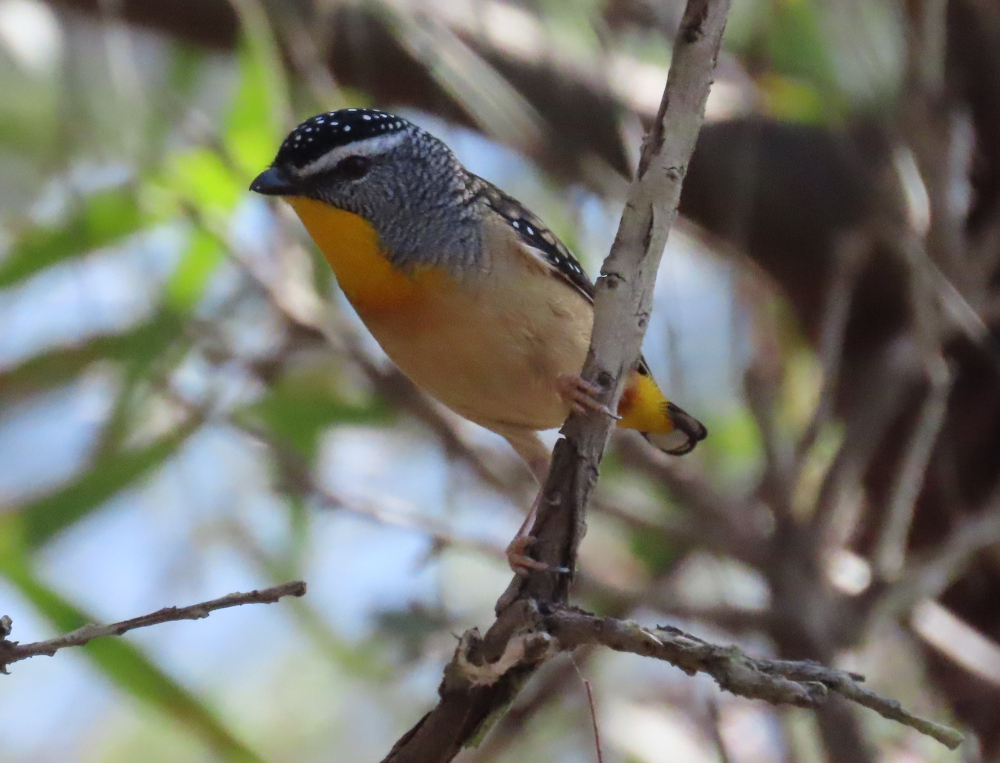
Pardalotes are native to Australia. There are four species in the Pardalote family, of which we have just one in our area near Sydney.
An unusual characteristic is that, although they spend much of their time high in the treetops, they build their nests in tunnels in the ground. Take a look at my other posts to see videos of these birds entering into and emerging from their tunnels.
Common name: Spotted Pardalote or Diamondbird
Scientific name: Pardalotus punctatus
Approximate length: 10 cm
Date spotted: 19 June 2025 (winter)
Location: Manly Dam, NSW, Australia: 33°46’38.6″S 151°14’55.8″E
Pardalotes nest-building in winter
It’s mid-winter here in Sydney: cold, wet, and grey. Yet I’ve noticed some of the birds are already preparing for breeding season. On Friday, I saw a group of Australian Ibises in breeding plumage. And a few days ago, I watched a Spotted Pardalote gathering material for its nest:

Pardalotes are tiny little birds (10 cm from head to tail). They nest in burrows in the ground, usually at around ankle level. This one was unusual, in that its nest was in the side of a low cliff, overlooking the water of Sydney Harbour. Here’s the view that the bird would see:

Some distance away on the same walk, another Spotted Pardalote stopped on a branch for a few seconds:

Even when stopped on a branch, these birds don’t stand still for any time at all! I was lucky to get some usable shots from the many that I took. Another view of the same bird:

Common name: Spotted Pardalote or Diamondbird
Scientific name: Pardalotus punctatus
Approximate length: 10 cm
Date spotted: 26 June 2024 (winter)
Location: Forty Baskets (33°48’05.7″S 151°16’09.3″E) and Dobroyd Head (33°48’35.0″S 151°16’18.8″E) in Sydney Harbour
Pardalotes nesting on a Sydney beach
Pardalotes are unusual in that they build their nests underground, usually at around ankle height. This morning I spotted a couple of the birds flitting around a grassy bank on a beach in Sydney Harbour. With a bit of patience and the benefit of my camera’s super zoom, I was able to see the birds going in and out of their nesting tunnel.
The next video shows the male bird waiting on a tree branch until the coast is clear, then flitting off towards the nest:
Here’s the female, also checking for danger near the nest:
These are Spotted Pardalotes, also called Diamondbirds. They’re one of the smallest of Australian birds, at approximately 10 cm from head to tail. I’m often surprised at how unbothered they seem by my presence.
The female has a pale, faun-coloured chest. Her head and back are prettily dotted with spots, and her tail is aflame with red and yellow.

The male has an orange-yellow chest. The white stripes across its eyes are more pronounced than those of the femail, and there’s more black on the head and back, making the white spots stand out.
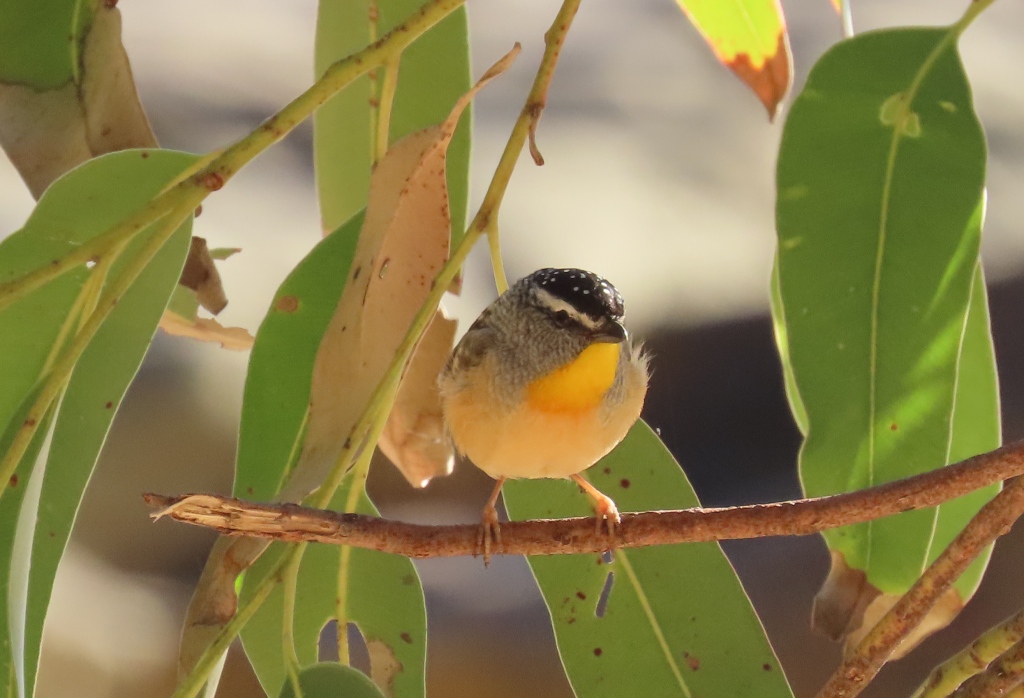
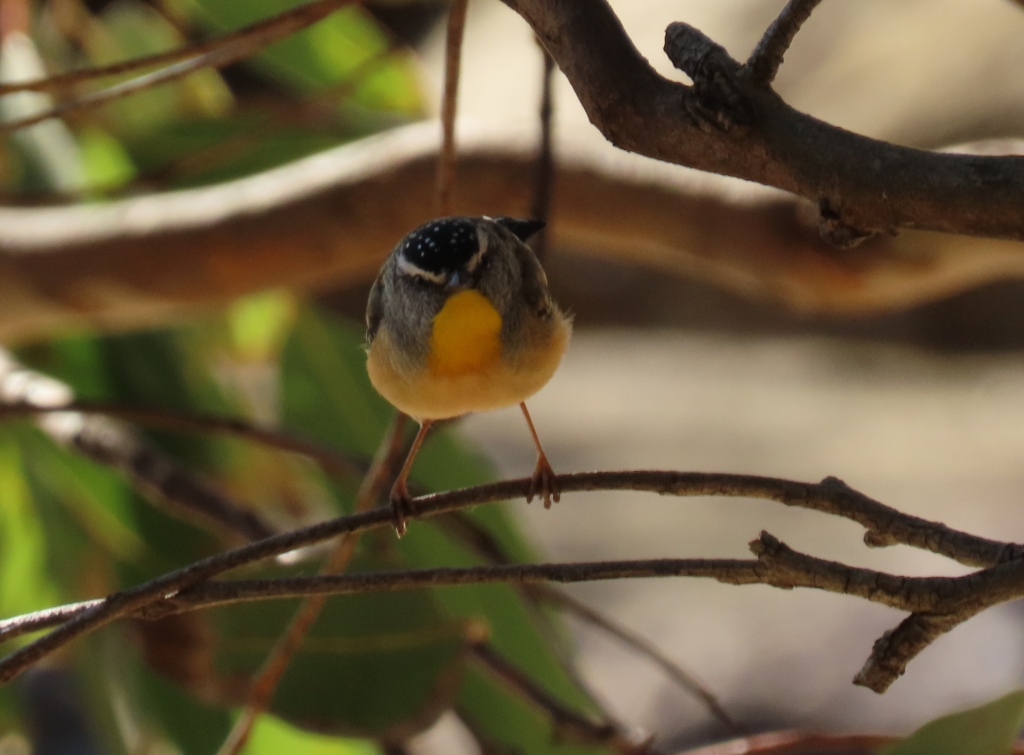
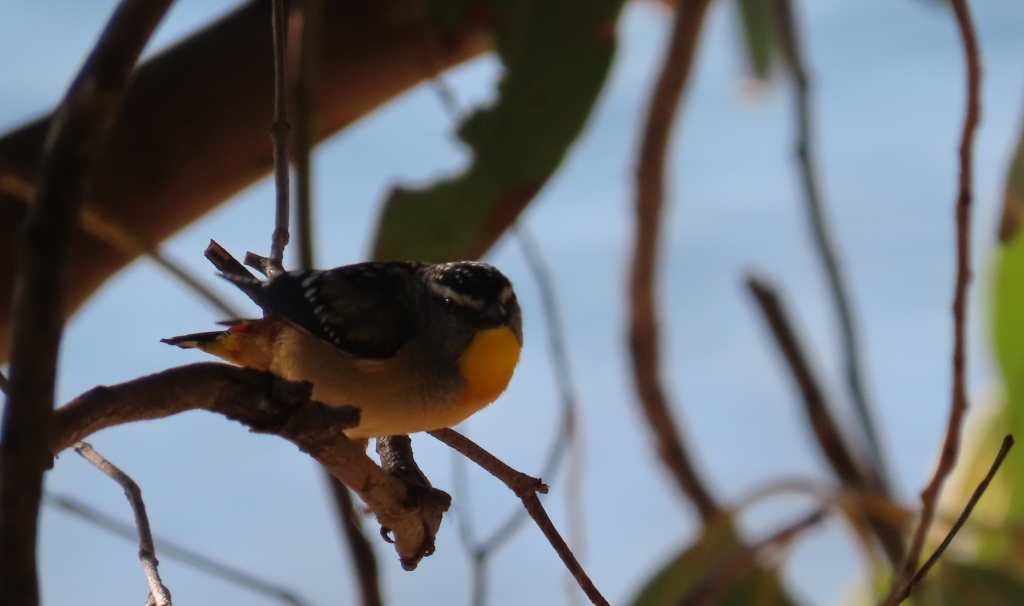
Common name: Spotted Pardalote or Diamondbird
Scientific name: Pardalotus punctatus
Approximate length: 10 cm
Date spotted: 29 July 2023 (winter)
Location: Reef Beach in Sydney Harbour
Spiffy little Red-browed Finches and a Pardalote
In the muted tones of a wintry day in the bush after rain, the green and red colouring of the Red-browed Finches stands out cheerily:
Red-browed finches are small (about 12 centimetres from beak to tail) and fast-moving. The red on their brow and tail can be quite vivid, as in this little one.

Common name: Red-browed Finch
Scientific name: Neochmia temporalis
Approximate length: 12 cm
Date spotted: 17 July 2023 (winter)
Location: Manly Dam park, near Sydney: 33°46’48.7″S 151°15’03.9″E
There were a couple of Pardalotes hopping around too:
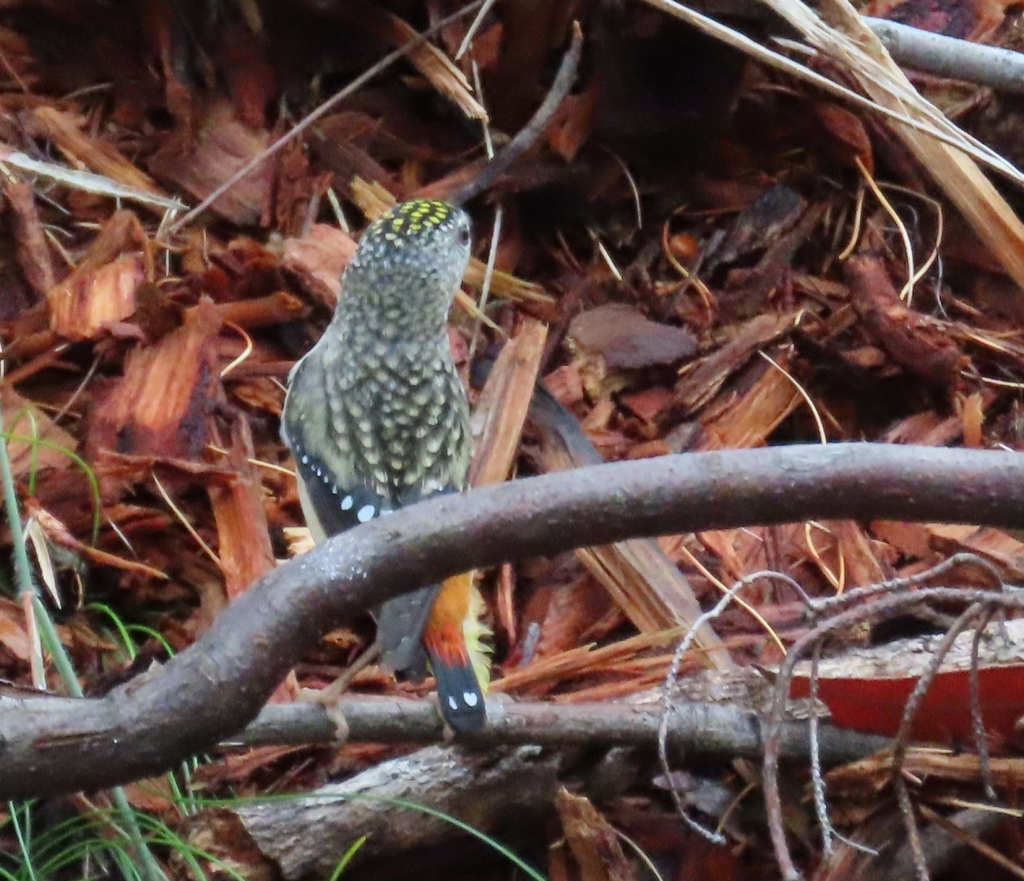
I’ve shown better pics of Pardalotes in earlier posts.
Common name: Spotted Pardalote
Scientific name: Pardalotus punctatus
Approximate length: 10 cm
Date spotted: 17 July 2023 (winter)
Location: Manly Dam park, near Sydney: 33°46’48.7″S 151°15’03.9″E
Video of Pardalote emerging from nest
Walking along a path in Manly Dam park this morning, I saw a flash of movement down at ankle level. A little bird had flown straight into the bank on the left of the path:

Pardalotes, tiny as they are, are unusual in that they dig holes in banks of earth to nest in. Here’s a closer view of the area where the bird disappeared:
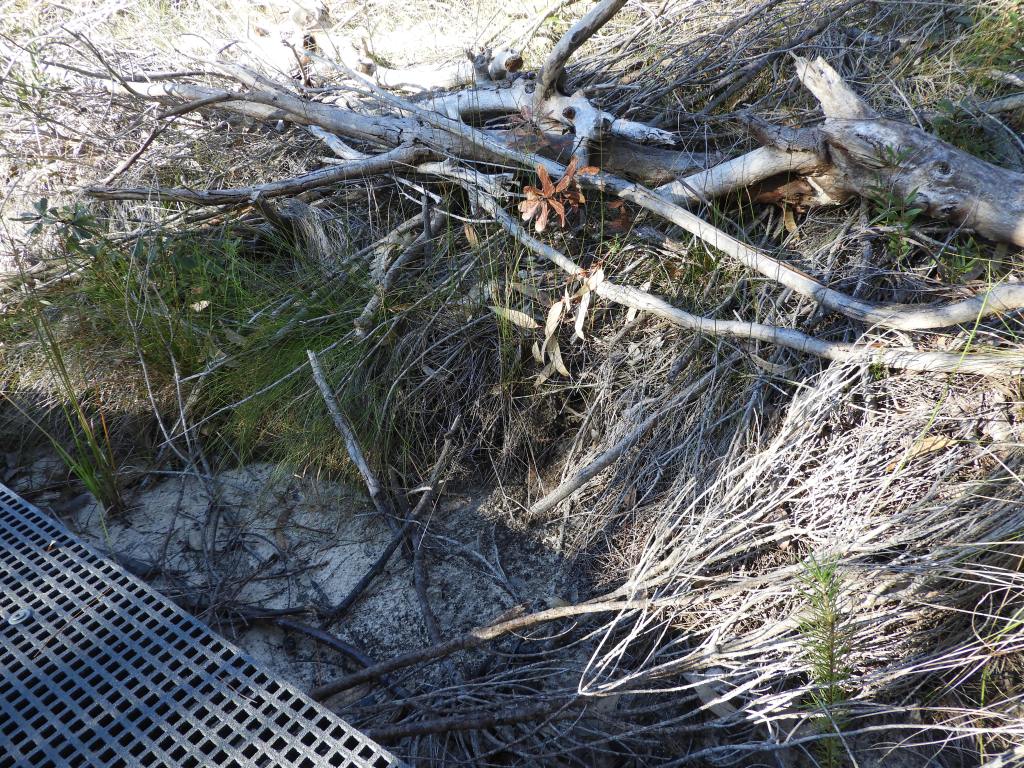
So I trained my camera on the area and waited. After a few minutes, my patience was rewarded. In the video below, watch the top right of the picture. You’ll see the tiny head of a Spotted Pardalote appear. The bird examines the surroundings carefully before emerging and flying away:
Update: A week or so later, on 12 June, I was walking in the same spot when a bird emerged from the same nest and perched on a branch close by. I managed to get a still photo. Here it is:
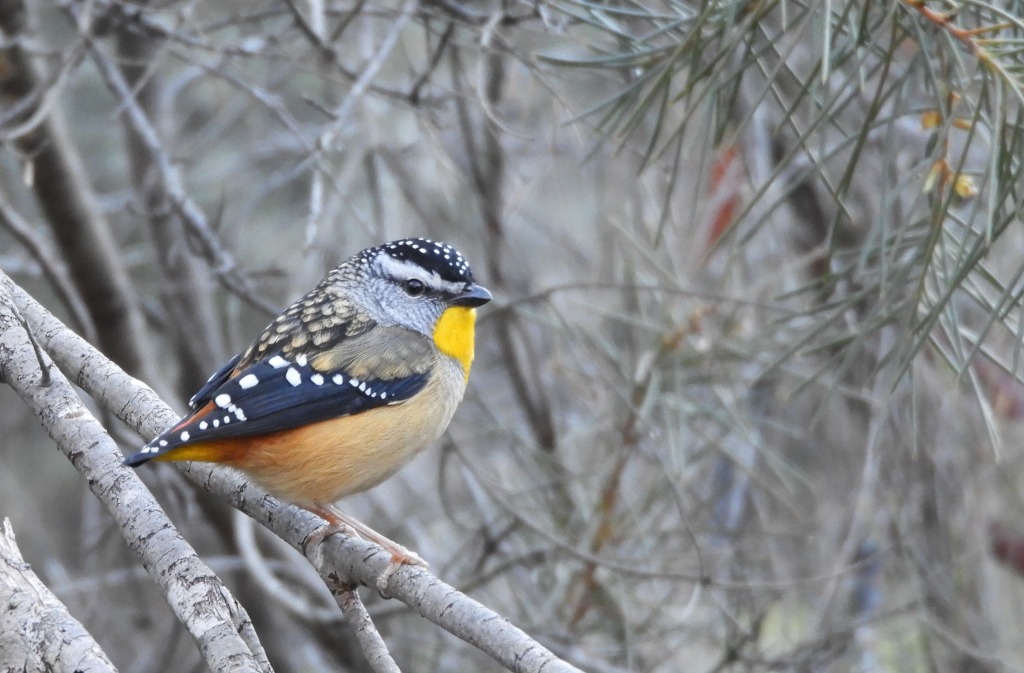
I’ve posted more pics of Pardalotes in earlier posts.
Common name: Spotted Pardalote
Scientific name: Pardalotus punctatus
Approximate length: 10 cm
Date spotted: 6 June 2021 (winter)
Location: Manly Dam Park, New South Wales, Australia
Pretty Pardalote on a Banksia bush
Pardalotes are tiny birds that manage to pack a lot of prettiness into sleek bundle. A couple of days ago I saw one foraging in a Banksia bush. It was probably picking tiny bugs (psyllids) from the leaves, or it could be drinking. I noticed in the photo that there are droplets of water on the twig near the bird’s feet:

A view from the top shows the spots on the bird’s head. It also demonstrates how nicely camouflaged the bird is in its natural environment:

Common name: Spotted Pardalote
Scientific name: Pardalotus punctatus
Approximate length: 10 cm
Date spotted: 25 May 2021 (late autumn)
Location: Manly Dam Park, New South Wales, Australia: 33°46’47.3″S 151°15’02.2″E
Who said a Pardalote isn’t a dinosaur?
Well, I guess maybe nobody has ever said “a Pardalote isn’t a dinosaur”. I mean, why would you? Still, this little Pardalote’s plucky pose made me think of a dinosaur in a Spielberg movie. At the very least, it was considering auditioning for the role:
Although they’re only 10 centimetres tall, Spotted Pardalotes don’t seem to be daunted by huge creatures like me standing close by. This one was on a twig a few metres away, singing its heart out with a pause to grab a bite to eat:
It seemed to find me as interesting as I found it:
Did any dinosaur ever catch the sun as prettily as this?
Common name: Spotted Pardalote
Scientific name: Pardalotus punctatus
Approximate length: 10 cm
Date spotted: 22 July 2019 (Winter)
Location: Manly Dam National Park, New South Wales, Australia: 33°46’24.4″S 151°15’03.6″E
Pardalotes nesting and dancing
Pardalotes are tiny, neat little birds that usually spend very little time in one spot. So when I was walking along a bush path this morning, I was surprised when a female pardalote kept flitting up to a branch near me and stopping to peer at me. She’d also twitch from side to side, as if dancing.
Then a male bird arrived and fluttered from branch to branch around me. Then another female.
They didn’t seem worried, just attentive.
It dawned on me that I might be near their nest. Pardalotes are unusual in that they nest in holes just above ground level, usually dug into in a bank of earth. So I looked down towards my feet. Sure enough, there was a series of entrances dug into the bank near my ankles.
The nesting tunnels are nicely shored up by a strong wooden pole provided by some obliging person. Just the ticket for a pardalote home!
I moved a few steps further down the path, then stopped to watch. Now that I was out of the way, the birds were happy to visit their homes again. I saw birds popping in and out of two of the tunnels. The short clip below shows one of the female birds balancing on the slope outside a nesting hole, then flying away:
The video below shows the female flying away from the tunnel entrance, then returning and going inside, then there’s some footage of the male bird on a nearby branch. This is the only shot I managed to get of the male:
Another shot of one of the females:
And another, from a different angle:
Here’s a general shot of the bushland around the birds. An open forest of eucalypts and banksia. What a lovely place to live, even in the midst of a Sydney winter:
Common name: Spotted Pardalote
Scientific name: Pardalotus punctatus
Approximate length: 10 cm
Date spotted: 1 July 2018 (Winter)
Location: Manly Dam National Park, New South Wales, Australia: 33°46’26.9″S 151°15’00.3″E
Pardalote eating lerp
Pardalotes are very small, compact birds. They move fast, so it’s hard to catch one on film. This one is hanging upside down, snapping up lerp (I think) off a leaf.
Update on Tuesday 11 November: I originally wrote that the bird was snapping up insect eggs. But since then I’ve started reading Where song began by Tim Low. He describes how Pardalotes and other Australian birds scrape lerp off leaves. Lerp is a sweet carbohydrate excreted by tiny insects called psyllids.
I couldn’t get a good angle to see the whole bird all at once, but this short video gives a good idea of what it looks like.
Common name: Spotted Pardalote
Scientific name: Pardalotus punctatus
Approximate length: 10 cm
Date spotted: 2 November 2014
Season: Spring
Location: Manly Dam National Park, New South Wales, Australia
Latitude/longitude: 33°46’36.3″S 151°15’14.9″E






